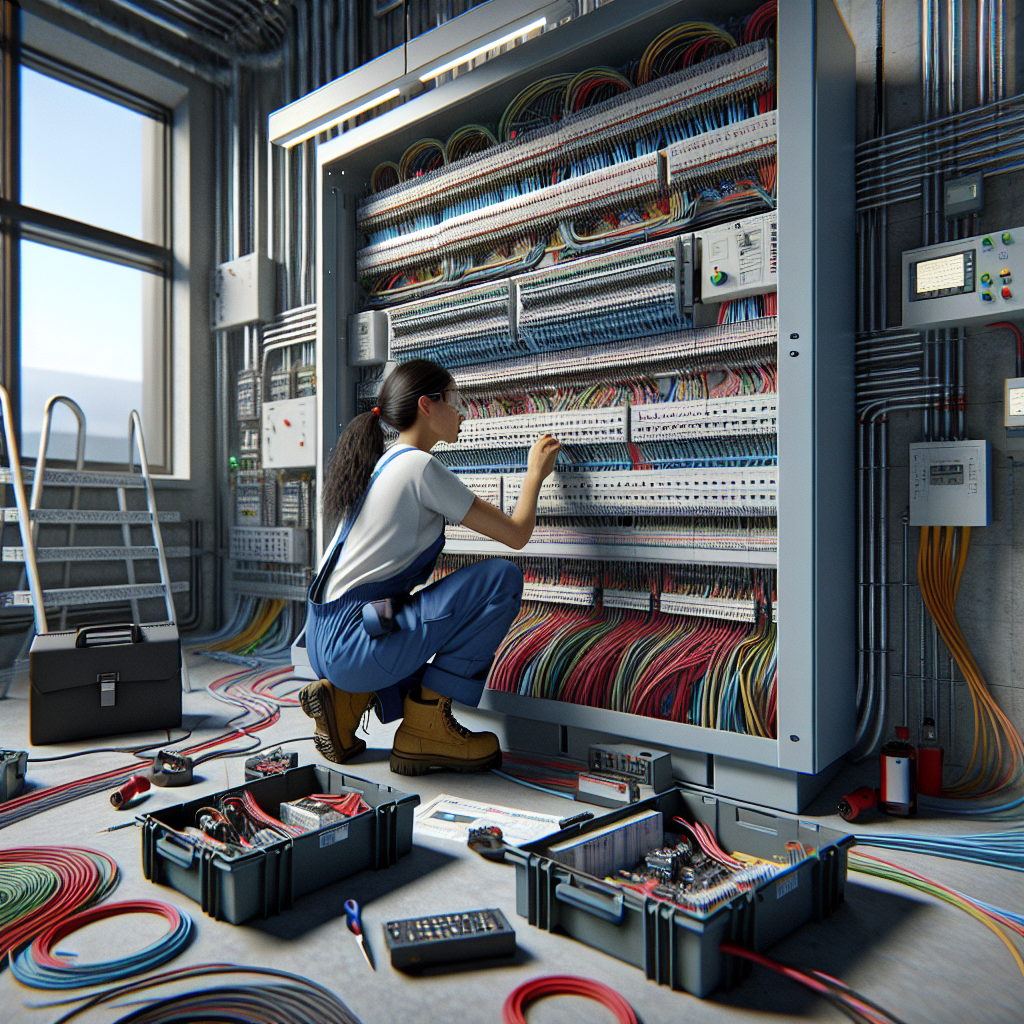In today’s rapidly evolving technological landscape, *low voltage systems* have become an essential component for both residential and commercial infrastructures. These systems, typically operating at 50 volts or less, are crucial for powering a myriad of applications ranging from security systems to smart home technologies. The demand for efficient and reliable low voltage systems has surged due to their safety, energy efficiency, and versatility.
**Low voltage systems** are commonly used in various sectors including telecommunications, data networking, and building management. They are designed to meet the specific needs of different environments while ensuring optimal performance and minimal power consumption. By integrating these systems, businesses and homeowners can enjoy enhanced security, improved connectivity, and smarter automation.
Understanding the basic principles and applications of low voltage systems is paramount for anyone looking to upgrade their infrastructure. Whether you are a business owner aiming to improve your operational efficiency or a homeowner seeking to modernize your living space, low voltage systems offer a range of benefits that can significantly enhance your daily operations.
Visit our website to learn more and get started today! Click here.
Benefits of Low Voltage Systems

The adoption of low voltage systems offers a plethora of benefits that make them an attractive choice for both residential and commercial settings. One of the most significant advantages is enhanced safety. Operating at lower voltages reduces the risk of electrical shocks and fire hazards, making these systems ideal for environments where safety is a top priority.
Another major benefit is energy efficiency. Low voltage systems typically consume less power compared to their high-voltage counterparts. This not only helps in reducing energy bills but also contributes to a more sustainable and eco-friendly environment. As businesses and homeowners increasingly prioritize energy conservation, low voltage systems stand out as a viable solution.
**Versatility** is another key advantage. Low voltage systems can be seamlessly integrated into various applications such as lighting, security, and automation. This flexibility allows for tailored solutions that meet the specific needs of different users. For instance, in a smart home setup, low voltage systems can control everything from lighting to heating and cooling, providing a cohesive and efficient living experience.
Moreover, cost-effectiveness is a compelling factor. The installation and maintenance of low voltage systems are generally less expensive compared to high-voltage systems. This cost efficiency makes it a practical choice for long-term investments, ensuring that users get the most value for their money.
Examples of Low Voltage Systems
Low voltage systems are employed in a wide range of applications, each showcasing their versatility and efficiency. One of the most common examples of low voltage systems is in **security systems**. These systems use low voltage to power surveillance cameras, alarm systems, and access control units, ensuring robust security without the high energy costs.
Another prevalent example is found in **smart home technology**. Low voltage wiring is the backbone of many smart home devices, including smart thermostats, lighting controls, and automated blinds. These systems allow homeowners to easily manage their environment, enhancing comfort and convenience.
**Telecommunication networks** also heavily rely on low voltage systems. Structured cabling for internet and phone networks often uses low voltage wiring to ensure reliable and efficient data transmission. This is essential in both residential and commercial settings where seamless communication is critical.
In the realm of **audio-visual systems**, low voltage wiring is used to connect speakers, projectors, and other multimedia devices. This ensures high-quality sound and video output, making it a popular choice for home theaters, conference rooms, and educational institutions.
**Lighting systems** are another significant application. Low voltage lighting, such as LED lights, is not only energy-efficient but also offers greater control over brightness and color. This makes it an ideal solution for both indoor and outdoor lighting needs, providing aesthetic appeal along with functionality.
Security and Surveillance Applications

When it comes to **security and surveillance applications**, low voltage systems are indispensable. These systems are designed to provide robust security solutions while maintaining energy efficiency. One of the primary components of these systems is **CCTV (Closed-Circuit Television)**. CCTV cameras operate on low voltage and are crucial for monitoring and recording activities in both residential and commercial properties.
**Access control systems** are another critical application. These systems use low voltage to manage entry points through keycards, biometric scanners, or keypads. By controlling who has access to specific areas, these systems enhance security and help prevent unauthorized entry.
Alarm systems also heavily rely on low voltage wiring. These systems include **motion detectors**, **door/window sensors**, and **alarm panels** that communicate with a central control unit. When an intrusion is detected, the system can alert the property owner or a monitoring service, ensuring a rapid response to potential threats.
In addition to these components, **intercom systems** are often used in conjunction with low voltage wiring. Intercoms facilitate communication between different parts of a building, enhancing both security and convenience. This is particularly useful in multi-story buildings or large commercial complexes.
Finally, **network-based surveillance systems** are becoming increasingly popular. These systems use low voltage wiring to connect IP cameras to a network, allowing for remote monitoring and storage of footage. This capability is essential for businesses that need to keep an eye on multiple locations simultaneously.
Smart Home Technology Integration

**Smart home technology integration** is revolutionizing the way we interact with our living spaces, and low voltage systems play a crucial role in this transformation. The foundation of any smart home setup is a well-structured low voltage network that connects various devices and systems efficiently and reliably.
One of the most popular applications is **smart lighting systems**. These systems use low voltage wiring to connect LED lights to a central control unit, allowing homeowners to adjust lighting levels, colors, and schedules through a smartphone app or voice command. This not only enhances convenience but also offers significant energy savings.
**Home automation systems** are another essential aspect of smart home technology. These systems integrate various low voltage devices, such as thermostats, door locks, and window shades, providing centralized control over the home’s environment. For instance, a smart thermostat can learn your daily routine and adjust the temperature accordingly, optimizing comfort and energy efficiency.
**Security systems** within smart homes also benefit from low voltage integration. Smart cameras, doorbell cameras, and motion sensors can be connected to a central hub, allowing homeowners to monitor their property in real-time from anywhere in the world. Notifications and alerts can be sent directly to a smartphone, ensuring that any security concerns are promptly addressed.
**Audio and video distribution** is another area where low voltage systems excel. Multi-room audio systems enable users to play music throughout their home, while centralized video distribution allows for seamless streaming of content to multiple screens. These systems ensure high-quality performance while minimizing energy consumption.
In addition, low voltage wiring supports **networking infrastructure** essential for smart home devices. Reliable Wi-Fi and Ethernet connections are critical for the smooth operation of smart devices, and a well-designed low voltage network ensures strong and consistent connectivity throughout the home.
Commercial and Industrial Uses

The applications of **low voltage systems** extend far beyond residential settings and are pivotal in **commercial and industrial environments**. These systems provide the backbone for various operational and safety functions, ensuring efficiency, reliability, and cost-effectiveness.
One of the most critical uses is in **building management systems (BMS)**. These systems leverage low voltage wiring to integrate and control HVAC, lighting, and security systems within a commercial building. A BMS can optimize energy usage, reduce operational costs, and enhance the comfort and safety of occupants by providing centralized control and monitoring.
**Access control systems** are another essential application in commercial settings. These systems use low voltage wiring to connect card readers, biometric scanners, and electronic locks, ensuring that only authorized personnel can enter restricted areas. This not only enhances security but also allows for detailed tracking of personnel movement within the facility.
In industrial environments, **low voltage systems** are crucial for **process automation and control**. They connect various sensors, actuators, and controllers, enabling precise monitoring and management of manufacturing processes. This leads to improved product quality, reduced downtime, and increased overall productivity.
**Surveillance systems** in commercial and industrial contexts also rely heavily on low voltage infrastructure. High-definition cameras, motion detectors, and alarm systems are interconnected to provide comprehensive security coverage. These systems can be remotely monitored and controlled, offering real-time insights and rapid response capabilities.
Another significant application is in **data and communication networks**. Low voltage cabling ensures reliable and high-speed data transmission, which is vital for the smooth operation of business processes. This includes everything from internal communication systems to internet connectivity and cloud services.
Additionally, **audio-visual systems** in conference rooms and public address systems in large facilities require robust low voltage wiring to function effectively. These systems support presentations, meetings, and announcements, enhancing communication and collaboration within the organization.
For businesses and industries looking to enhance their infrastructure with reliable low voltage systems, we offer comprehensive solutions tailored to meet your specific needs. Visit our website to learn more and get started today! Click here.

